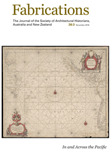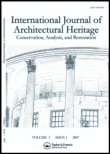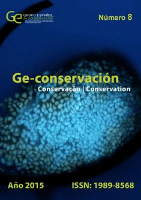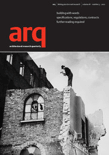
Disegnare Idee Immagini-Ideas Images
Scope & Guideline
Fostering Dialogue in Architecture and the Arts
Introduction
Aims and Scopes
- Interdisciplinary Approaches to Drawing and Architecture:
The journal focuses on the integration of various disciplines such as history, technology, and art in the study of drawing and architecture, fostering a holistic understanding of built environments. - Cultural Heritage and Preservation:
Significant attention is given to the representation and preservation of cultural heritage, emphasizing methodologies for documenting and interpreting historical sites and architectural works. - Narrative and Representation in Drawing:
The exploration of drawing as a narrative tool is a core theme, examining how drawings convey stories and ideas beyond mere representation. - Technological Innovations in Design:
The journal showcases advancements in digital tools and methodologies that enhance the practice of drawing and architectural representation, reflecting the evolving nature of the discipline. - Critical Analysis of Architectural History:
A consistent focus on analyzing historical architectural works and figures provides insights into their impact and relevance in contemporary contexts.
Trending and Emerging
- Digital Representation and Virtual Environments:
There is a growing emphasis on the use of digital tools and virtual environments for representation and analysis, indicating a shift towards more technologically-driven methodologies. - Sustainable and Resilient Design:
Recent publications reflect a heightened interest in sustainable practices and resilience in architecture, addressing the pressing global issues of climate change and environmental impact. - Interdisciplinary Collaboration:
The trend towards interdisciplinary research is evident, with increasing collaborations across fields such as digital media, cultural studies, and technology, enhancing the richness of architectural discourse. - Cultural and Emotional Aspects of Drawing:
An emerging focus on the emotional and nostalgic dimensions of drawing suggests a deeper exploration of how visual representation influences human experience and cultural memory. - Archaeological and Historical Analysis:
Papers that analyze archaeological sites and historical architecture are gaining prominence, reflecting a renewed interest in understanding the past to inform contemporary practices.
Declining or Waning
- Traditional Architectural Techniques:
There has been a noticeable decrease in the exploration of traditional architectural drawing techniques, which may indicate a shift towards more contemporary and digital methods. - Historical Architectural Styles:
Discussions centered around specific historical styles of architecture appear to be waning, possibly as the focus moves towards interdisciplinary and innovative approaches rather than style-specific analysis. - Local Case Studies in Urban Studies:
The frequency of papers focusing on localized case studies in urban transformations has diminished, suggesting a trend towards broader, more generalizable studies.
Similar Journals

Fabrications-The Journal of the Society of Architectural Historians Australia and New Zealand
Unveiling the Rich Tapestry of Architectural HistoryFabrications - The Journal of the Society of Architectural Historians Australia and New Zealand is a vital scholarly platform that explores the rich interplay between architecture and its historical context within the Australasian landscape. Published by Routledge Journals, Taylor & Francis Ltd, this journal serves as a crucial resource for researchers, professionals, and students in the fields of architectural history, urban studies, and visual arts. With an ISSN of 1033-1867 and an E-ISSN of 2164-4756, Fabrications has received recognition for its quality, placing in the Q4 category in Urban Studies and Q2 in Visual Arts and Performing Arts as of 2023. This journal not only welcomes innovative research articles but also encourages the exploration of New Zealand and Australian cultural heritage through diverse architectural narratives. With publications spanning significant years since its inception in 1989, Fabrications continues to provide an open forum for dialogue and discovery, catering to the academic and professional community's growing interest in architectural narratives through a regional lens.

Bulletin KNOB
Illuminating the Intersection of Arts and HeritageBulletin KNOB, published by the KONINKLIJKE NEDERLANDSE OUDHEIDKUNDIGE BOND-KNOB, is a reputable Open Access journal that has been disseminating knowledge since 1899, with a continued commitment to making research accessible to all. Based in the Netherlands, this journal provides a platform for scholarly articles that span the fields of Conservation, History, and the Visual Arts and Performing Arts. With its 2023 Scopus rankings placing it in the top quartiles within its category, Bulletin KNOB is recognized for its significant contribution to the advancement of these disciplines. Researchers, professionals, and students alike are encouraged to engage with the journal's diverse content that bridges historical narratives with contemporary practices, fostering a deeper understanding of cultural heritage. The journal’s commitment to excellence is further reflected in its Q3 and Q4 quartile rankings, making it an essential resource for anyone dedicated to the study of the arts and humanities.

Radovi Instituta za Povijest Umjetnosti-Journal of the Institute of Art History
Bridging Theory and Practice in Art Scholarship.Radovi Instituta za Povijest Umjetnosti-Journal of the Institute of Art History is a distinguished academic journal dedicated to the exploration and critical analysis of art history, with a special emphasis on the visual arts and performing arts. Published by INST POVIJEST UMJETNOSTI-INST ART HISTORY in Croatia, this journal provides an essential platform for researchers and practitioners to disseminate their findings and engage in scholarly discourse. Since its transition to Open Access in 2008, it has significantly increased the accessibility of its content, fostering a global exchange of ideas. The journal is indexed in notable databases, reflecting its impact within its field, with a current ranking that places it in the Q4 category for History and in Q3 for Visual Arts and Performing Arts. As it spans its converged years from 2015 to 2024, Radovi is poised to expand its influence and continue contributing to the understanding of art historical narratives. Researchers, professionals, and students alike will find this journal a valuable resource for contemporary discussions and theoretical advancements in the study of art.

International Journal of Architectural Heritage
Preserving the Past, Shaping the Future.The International Journal of Architectural Heritage is a premier publication dedicated to the multidisciplinary fields of architecture, conservation, and visual arts. Published by TAYLOR & FRANCIS INC, this journal serves as a vital platform for scholars and practitioners who aim to advance knowledge in the preservation of cultural heritage and architectural innovation. With an impressive impact factor reflecting its critical acclaim, including rankings in the top quartile (Q1) across multiple categories in 2023, the journal is recognized as a key resource in Arts and Humanities, particularly in Visual Arts and Performing Arts and Conservation. Since its inception in 2007, the journal has consistently provided rigorous peer-reviewed research, offering enriching insights and fostering collaborations amongst students, researchers, and professionals committed to the future of architectural heritage. As it continues to influence the field through its diverse and impactful contributions, readers can expect to engage with leading-edge studies that not only illuminate current trends but also inspire innovative practices in safeguarding architectural legacies.

EGA-Revista de Expresion Grafica Arquitectonica
Cultivating Scholarly Excellence in Graphic Architectural ExpressionEGA-Revista de Expresion Grafica Arquitectonica is a premier academic journal published by UNIV POLITECNICA VALENCIA, EDITORIAL UPV, specializing in the fields of architecture and visual arts. This Open Access journal has been a vital resource for scholars since its inception in 2003, facilitating the dissemination of innovative research and practice in these dynamic disciplines. With an exemplary Q2 ranking in Architecture and a stellar Q1 position in Visual Arts and Performing Arts for 2023, EGA exemplifies high standards of scholarly excellence, making it a critical platform for interdisciplinary dialogue. Its impact is further underscored by its Scopus rankings, placing it at the 67th percentile in Visual Arts and Performing Arts and the 41st percentile in Architecture, reflecting its growing influence within the academic community. Designed for researchers, professionals, and students alike, EGA aims to foster insightful exchange and knowledge advancement, thereby enhancing the future of architecture and artistic expression.

ArcHistoR-Architecture History Restoration
Innovating Restoration Practices for Future GenerationsArcHistoR-Architecture History Restoration is an esteemed open-access journal published by UNIV MEDITERRANEA REGGIO CALABRIA since 2014, focused on the multifaceted domains of architecture, history, and visual arts. This journal serves as a vital platform for the dissemination of research findings, innovative methodologies, and critical discussions surrounding the restoration and history of architectural practices, appealing to a diverse audience of researchers, professionals, and students in these fields. With a commitment to scholarly excellence, ArcHistoR has positioned itself within the academic community, reflected in its ranking in the 2023 category quartiles, where it secured Q4 in Architecture and Q3 in both History and Visual Arts and Performing Arts. The journal facilitates global collaboration and knowledge sharing in its areas of expertise, further underscoring its relevance and significance. Based in Italy, effective communication and cooperation in the restoration community can flourish through the journal's purview. For those dedicated to expanding their understanding and contributing to the discourse on architectural history and restoration, ArcHistoR is an invaluable resource.

Ge-Conservacion
Uniting Disciplines for a Sustainable Cultural LegacyGe-Conservacion, published by GRUPO ESPANOL I I C, stands as a pivotal journal in the fields of Conservation, Museology, and Visual Arts and Performing Arts, facilitating an open-access platform since 2009. Based in Spain, this journal serves as a vital repository for innovative research and scholarly dialogue, significantly impacting the community with its Q1 and Q2 rankings across several categories in 2023. With an objective to advance multidisciplinary understanding and practices related to cultural heritage conservation, it attracts a diverse readership of researchers, professionals, and students eager to engage with contemporary issues and methodologies. The journal's commitment to accessibility enhances its reach and influence, making it an essential resource for anyone passionate about preserving the integrity and significance of our artistic and historical treasures.

Festival dell Architettura Magazine
Innovating Spaces: Where Architecture Meets CultureFestival dell Architettura Magazine, published by FESTIVAL ARCHITETTURA EDIZIONI, is a distinctive Open Access journal dedicated to the realms of architecture, urban studies, and the visual and performing arts. Established with a vision to foster interdisciplinary dialogue, the journal has been a part of the academic landscape since 2013 and has converged its insightful contributions from 2018 to 2023. Despite being ranked in the lower quartiles in its respective categories—Q4 in Architecture and Urban Studies, and Q3 in Visual Arts and Performing Arts—this publication remains vital for emerging researchers and seasoned professionals alike, as it provides a platform for innovative ideas and practices from Italy and beyond. It serves as a key resource for those who wish to engage with contemporary architectural thought and cultural expressions, facilitating open access to research that highlights the intersections of space, society, and art.

Architecture and Culture
Advancing Interdisciplinary Insights in Built EnvironmentsArchitecture and Culture is an esteemed journal published by Routledge Journals, Taylor & Francis Ltd, focusing on the intersection of architecture, cultural studies, urbanism, and the visual and performing arts. Since its inception, this journal has become a vital platform for researchers, professionals, and students to explore the multifaceted relationship between architecture and cultural identity within contemporary contexts. With an ISSN of 2050-7828 and an E-ISSN of 2050-7836, the journal reaches a global audience from its base in the United Kingdom. Featuring a commendable Q2 ranking in Visual Arts and Performing Arts and a consistent presence in multiple relevant quartiles, including Q3 in both Architecture and Cultural Studies, it is well-regarded for its scholarly impact. The journal offers a unique opportunity for interdisciplinary dialogue, fostering innovative research that examines how built environments shape and are shaped by cultural narratives. This commitment to advancing knowledge in these fields is reflected in its ongoing publication from 2014 to 2024, making it a pivotal resource for those at the forefront of the discourse on architecture and culture.

arq-Architectural Research Quarterly
Exploring the Intersection of Architecture and the Artsarq-Architectural Research Quarterly, published by Cambridge University Press, is a leading journal in the fields of architecture, visual arts, and performing arts. With an ISSN of 1359-1355 and an E-ISSN of 1474-0516, the journal has successfully captured the essence of architectural research since its inception in 1995. Recognized for its rigorous academic contributions, it currently holds a Q4 quartile in Architecture and a Q3 quartile in Visual Arts and Performing Arts as of 2023, reflecting its commitment to advancing knowledge within these disciplines. While it does not offer Open Access, it remains a crucial resource for scholars, professionals, and students seeking to explore innovative ideas and practices in architecture and the arts. The journal features a diverse range of articles that foster interdisciplinary dialogue, making it an indispensable platform for those interested in shaping the future of architectural discourse.